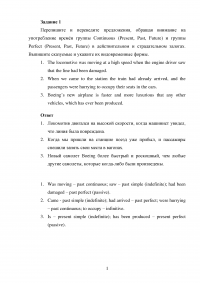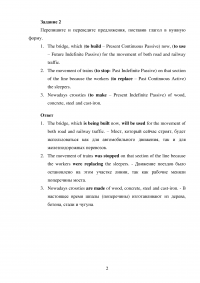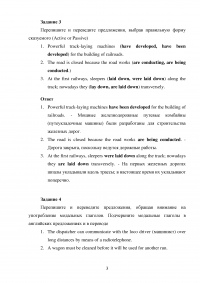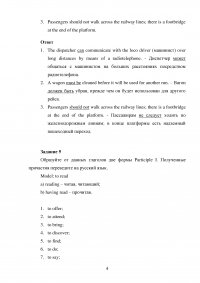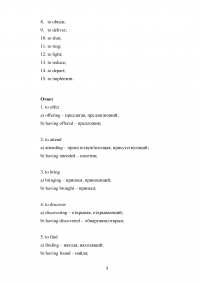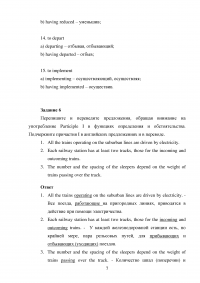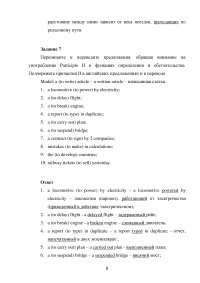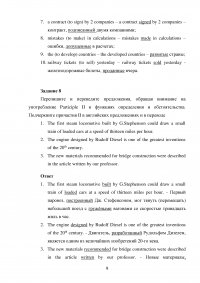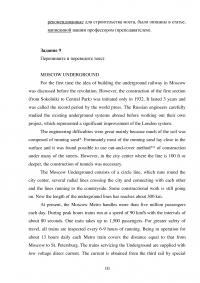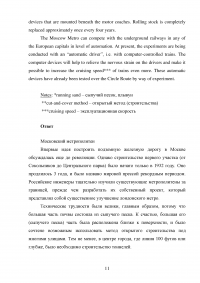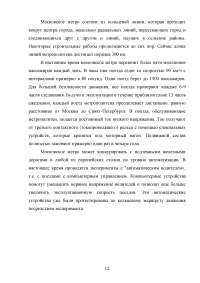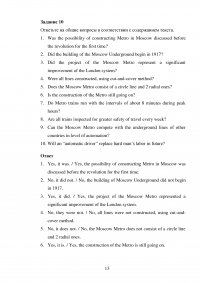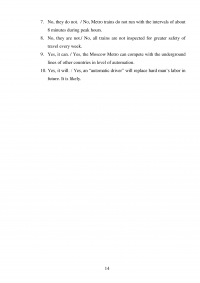Английский язык, 10 заданий, текст Moscow underground
| Код | 253274 | ||
| Дата создания | 2018 | ||
| Страниц | 14 ( 14 шрифт, полуторный интервал ) | ||
|
Файлы
|
|||
|
Без ожидания: файлы доступны для скачивания сразу после оплаты.
Ручная проверка: файлы открываются и полностью соответствуют описанию.
|
|||
Образцы страниц развернуть (14)
Описание
Содержание
Задание 1
Перепишите и переведите предложения, обращая внимание на употребление времён группы Continuous (Present, Past, Future) и группы Perfect (Present, Past, Future) в действительном и страдательном залогах. Выпишите сказуемые и укажите их видовременные формы.
- The locomotive was moving at a high speed when the engine driver saw that the line had been damaged.
- When we came to the station the train had already arrived, and the passengers were hurrying to occupy their seats in the cars.
- Boeing’s new airplane is faster and more luxurious that any other vehicles, which has ever been produced.
Ответ
...
Задание 2
Перепишите и переведите предложения, поставив глагол в нужную форму.
- The bridge, which (to build – Present Continuous Passive) now, (to use – Future Indefinite Passive) for the movement of both road and railway traffic.
- The movement of trains (to stop- Past Indefinite Passive) on that section of the line because the workers (to replace – Past Continuous Active) the sleepers.
- Nowadays crossties (to make – Present Indefinite Passive) of wood, concrete, steel and cast-iron.
Ответ
...
Задание 3
Перепишите и переведите предложения, выбрав правильную форму сказуемого (Active or Passive)
- Powerful track-laying machines (have developed, have been developed) for the building of railroads.
- The road is closed because the road works (are conducting, are being conducted.)
- At the first railways, sleepers (laid down, were laid down) along the track; nowadays they (lay down, are laid down) transversely.
Ответ
...
Задание 4
Перепишите и переведите предложения, обращая внимание на употребление модальных глаголов. Подчеркните модальные глаголы в английских предложениях и в переводе
- The dispatcher can communicate with the loco driver (машинист) over long distances by means of a radiotelephone.
- A wagon must be cleaned before it will be used for another run.
- Passengers should not walk across the railway lines; there is a footbridge at the end of the platform.
Ответ
...
Задание 5
Образуйте от данных глаголов две формы Participle I. Полученные причастия переведите на русский язык.
Model: to read
a) reading – читая, читающий;
b) having read – прочитав.
- to offer;
- to attend;
- to bring;
- to discover;
- to find;
- to do;
- to say;
- to obtain;
- to deliver;
- to shut;
- to ring;
- to light;
- to reduce;
- to depart;
- to implement.
Ответ
...
Задание 6
Перепишите и переведите предложения, обращая внимание на употребление Participle I в функциях определения и обстоятельства. Подчеркните причастия I в английских предложениях и в переводе.
- All the trains operating on the suburban lines are driven by electricity.
- Each railway station has at least two tracks, those for the incoming and outcoming trains.
- The number and the spacing of the sleepers depend on the weight of trains passing over the track.
Ответ
...
Задание 7
Перепишите и переведите предложения, обращая внимание на употребление Participle II в функциях определения и обстоятельства. Подчеркните причастия II в английских предложениях и в переводе
Model: a (to write) article – a written article – написанная статья.
- a locomotive (to power) by electricity;
- a (to delay) flight;
- a (to break) engine;
- a report (to type) in duplicate;
- a (to carry out) plan;
- a (to suspend) bridge;
- a contract (to sign) by 2 companies;
- mistakes (to make) in calculations;
- the (to develop) countries;
- railway tickets (to sell) yesterday.
Ответ
...
Задание 8
Перепишите и переведите предложения, обращая внимание на употребление Participle II в функциях определения и обстоятельства. Подчеркните причастия II в английских предложениях и в переводе
- The first steam locomotive built by G.Stephenson could draw a small train of loaded cars at a speed of thirteen miles per hour.
- The engine designed by Rudolf Diesel is one of the greatest inventions of the 20th century.
- The new materials recommended for bridge construction were described in the article written by our professor.
Ответ
...
Задание 9
Перепишите и переведите текст.
MOSCOW UNDERGROUND
For the first time the idea of building the underground railway in Moscow was discussed before the revolution. However, the construction of the first section (from Sokolniki to Central Park) was initiated only in 1932. It lasted 3 years and was called the record period by the world press. The Russian engineers carefully studied the existing underground systems abroad before working out their own project, which represented a significant improvement of the London system.
The engineering difficulties were great mainly because much of the soil was composed of running sand*. Fortunately most of the running sand lay close to the surface and it was found possible to use out-and-cover method** of construction under many of the streets. However, in the city center where the line is 100 ft or deeper, the construction of tunnels was necessary.
The Moscow Underground consists of a circle line, which runs round the city center, several radial lines crossing the city and connecting with each other and the lines running to the countryside. Some constructional work is still going on. Now the length of the underground lines has reaches about 300 km.
At present, the Moscow Metro handles more than five million passengers each day. During peak hours trains run at a speed of 90 km/h with the intervals of about 80 seconds. One train takes up to 1,500 passengers. For greater safety of travel, all trains are inspected every 6-9 hours of running. Being in operation for about 13 hours daily each Metro train covers the distance equal to that from Moscow to St. Petersburg. The trains servicing the Underground are supplied with low voltage direct current. The current is obtained from the third rail by special devices that are mounted beneath the motor coaches. Rolling stock is completely replaced approximately once every four years.
The Moscow Metro can compete with the underground railways in any of the European capitals in level of automation. At present, the experiments are being conducted with an “automatic driver”, i.e. with computer-controlled trains. The computer devices will help to relieve the nervous strain on the drivers and make it possible to increase the cruising speed*** of trains even more. These automatic devices have already been tested over the Circle Route by way of experiment.
Notes: *running sand – сыпучий песок, плывун
**cut-and-cover method – открытый метод (строительства)
***cruising speed – эксплуатационная скорость
Ответ
...
Задание 10
Ответьте на общие вопросы в соответствии с содержанием текста.
- Was the possibility of constructing Metro in Moscow discussed before the revolution for the first time?
- Did the building of the Moscow Underground begin in 1917?
- Did the project of the Moscow Metro represent a significant improvement of the London system?
- Were all lines constructed, using cut-and-cover method?
- Does the Moscow Metro consist of a circle line and 2 radial ones?
- Is the construction of the Metro still going on?
- Do Metro trains run with the intervals of about 8 minutes during peak hours?
- Are all trains inspected for greater safety of travel every week?
- Can the Moscow Metro compete with the underground lines of other countries in level of automation?
- Will an "automatic driver" replace hard man's labor in future?
Ответ
...
